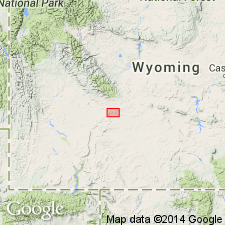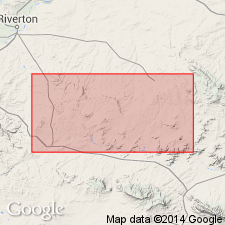
- Usage in publication:
-
- Beaver Divide conglomerate member
- Modifications:
-
- Named
- Dominant lithology:
-
- Conglomerate
- AAPG geologic province:
-
- Wind River basin
- Green River basin
Summary:
Name Beaver Divide applied to basal conglomerate of Chadron formation; formerly called Sweetwater member (preoccupied). Shown on geologic map, along north border of mapped area in Fremont County, Wyoming, in the Wind River basin, and as small outliers north of the Continental fault in the central part of mapped area, in Sweetwater County, Wyoming, in the Greater Green River basin. Consists of 68+/- feet of gray to black, cross-bedded, boulder, cobble, and pebble conglomerate in a coarse tuffaceous calcareous sandstone. The conglomerate is predominantly of black and dark-colored basic and ultrabasic igneous and metamorphic rock. Thickness varies. Conglomerate in measured section, on east side of North Oregon Butte, has angular and subangular, gray, boulder, cobble, and pebble conglomerate of schist, quartz, pink and white feldspar, porphyritic granite, gneiss, and nodules of buff and white volcanic ash and ashy sandstone in a coarse ashy calcareous sandstone matrix; coarsest near base. Disconformably overlies Continental Peak formation (new). Underlies unnamed upper part of Chadron. Age is early Oligocene. Report includes geologic map, stratigraphic table, cross section.
Named from Beaver Divide. Section measured on east side of North Oregon Butte, west-central part of sec. 2, T. 26 N., R. 101 W.
Source: Modified from GNU records (USGS DDS-6; Denver GNULEX).

- Usage in publication:
-
- Beaver Divide Conglomerate Member*
- Modifications:
-
- Areal extent
- Revised
- AAPG geologic province:
-
- Wind River basin
Summary:
Beaver Divide Conglomerate Member of White River Formation. (Adopted by the USGS.)
Adopted as a member of Oligocene White River Formation, in Wind River basin. Consists of a crystalline and a volcanic facies in study area: (1) crystalline facies is a poorly-sorted, grayish-orange, volcanic-rich sandstone with lenses of angular pebbles, cobbles and boulders of Precambrian and Tertiary rocks; (2) volcanic facies is a light-gray to yellowish-gray, crudely bedded, calcite-cemented volcanic sandstone and tuff interbedded with conglomerate of very poorly sorted angular to subround Tertiary volcanic fragments that range from sand size to boulders 8 feet long. Total thickness ranges from 80 feet in outcrops to as much as 125 feet in subsurface. Fossil mammals identified. Correlates with part of Wiggins Formation. Overlies newly named Big Draw Sandstone Lentil of White River Formation. Where lentil is not present, member lies unconformably on newly named Wagon Bed Formation.
Source: Modified from GNU records (USGS DDS-6; Denver GNULEX).
- Usage in publication:
-
- Beaver Divide Conglomerate Member*
- Modifications:
-
- Age modified
- AAPG geologic province:
-
- Wind River basin
Prothero, D.R., and Sanchez, Francisco, 2004, Magnetic stratigraphy of the middle to upper Eocene section at Beaver Divide, Fremont County, central Wyoming: New Mexico Museum of Natural History and Science Bulletin, no. 26, p. 151-154.
Summary:
For more information, please contact Nancy Stamm, Geologic Names Committee Secretary.
Asterisk (*) indicates published by U.S. Geological Survey authors.
"No current usage" (†) implies that a name has been abandoned or has fallen into disuse. Former usage and, if known, replacement name given in parentheses ( ).
Slash (/) indicates name conflicts with nomenclatural guidelines (CSN, 1933; ACSN, 1961, 1970; NACSN, 1983, 2005, 2021). May be explained within brackets ([ ]).

